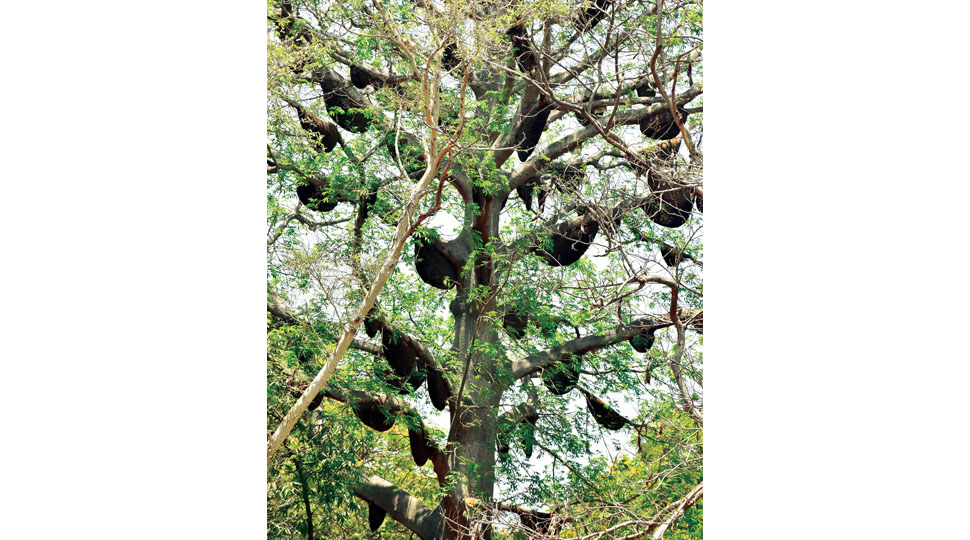Cottonwood tree near Hardinge Circle turns home to over 120 beehives
Mysore/Mysuru: Honeybees play a significant role in enhancing the allure of Mysuru. Over the past five to six decades, these bees, which have faced the challenges of disappearing populations, have been making a notable six-month visit to the city. During this time, they expand their family numbers before departing for other destinations.
Situated within the park owned by the Horticulture Department, stretching from Jayachamaraja Wadiyar Circle (Hardinge Circle) to Mirza Road stands a cottonwood tree (common in English as kapok tree – Ceiba pentandra) with a wide canopy. This tree has become a favoured destination for honeybees, providing them with a secure habitat.
For many decades, bee colonies have been arriving from unknown places, selecting this tree to breed and expand their hives. After their stay, they return to their origins. Despite the numerous trees in the park, it is fascinating to observe how honeybees meticulously choose separate branches of this specific cottonwood tree for each hive.
Over 100 beehives
A single tree hosts about 120 or more beehives, situated at heights ranging from approximately 35 to 45 feet. As the honeybee families grow, the hives extend to 2-3 trees adjacent to the main one.
Remarkably, with their impressive memory, the bees return to the same spot for each hive. They exhibit their remarkable memory by selecting the tree where they previously constructed hives, showcasing their incredible ability.
As the summer heat sets in, much like the arrival of the flowering season, the migration of honeybees to Mysuru commences. Every year, honeybees start arriving in the second week of December. This migration of honeybees aligns with the flowering season of various plants, providing honeybees with ample food sources.
Currently, there are approximately 120 or more hives spread across 3 to 4 trees next to the cottonwood tree, and by June, it is anticipated that this number could increase to 150 to 160. Some families vacate their regular spots upon finding space in other trees, while new families move in to occupy the vacated hives.
Protection from disruptive winds
There are a couple of reasons why honeybees choose this cottonwood tree. It offers protection from disruptive winds, provides essential food sources, water for drinking and easy accessibility. Experts suggest that this location has been relied upon by honeybees for many decades due to these favourable conditions.
The honeybees that have frequented the city for decades have caused no trouble to anyone. They only resort to aggression if provoked. In this park, honeybees have attacked horticulture workers only three to four times.
Since these incidents involved only one or two honeybees, the workers have not faced any serious consequences. These workers maintain a friendly relationship with the honeybees and continue working alongside them harmoniously.
Clearing beehives causes adversity
According to Wildlife Conservationist Pradeep, bees select the same location and the same tree every time they return because it is a safe place. In recent weeks, if there were beehives in buildings, houses, or private spaces, chemical treatments to eliminate them have been conducted. This will adversely affect agriculture and horticulture. If there are no bees, it is not possible to obtain fruits or crops, he noted.
In this context, it is essential to halt the killing of bees and protect their offspring. Awareness should be raised about this. “We are deeply involved in ensuring that the beehives constructed on buildings and private properties in and around Mysuru are relocated without causing trouble to the bees and residents. By setting up hives near trees and fields, they remain quiet. They serve their purpose,” he added.








Recent Comments